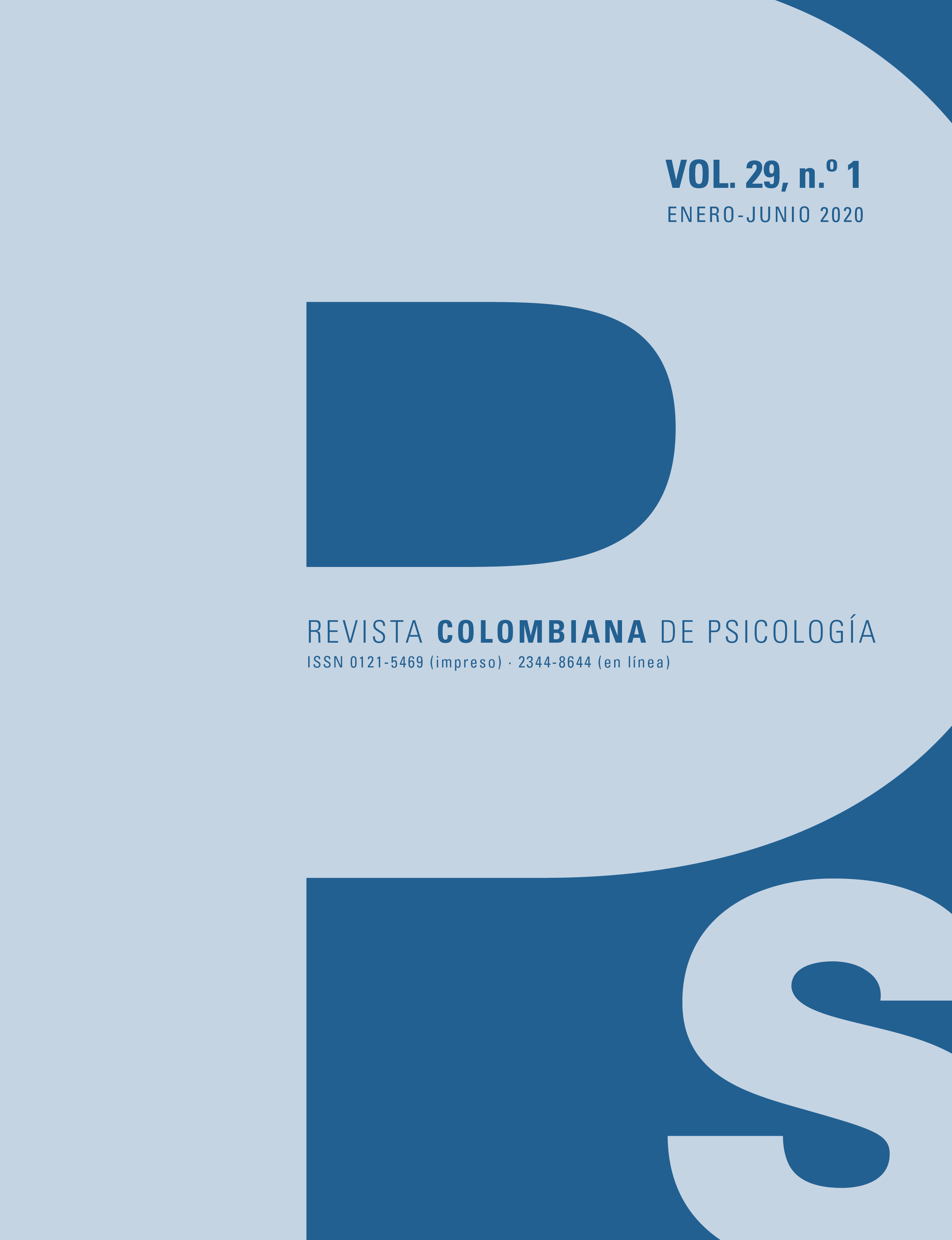Improving the Measurement of Children’s Mental Health Problems in Colombia with Item Response Theory
Cómo mejorar la medición de los problemas de salud mental en los niños colombianos mediante la Teoría de Respuesta al Ítem
Melhorando a mensuração de problemas de saúde mental em crianças na Colômbia usando a teoria da resposta ao item
DOI:
https://doi.org/10.15446/.v29n1.77214Keywords:
Item Response Theory, Test Information Function, Classical Test Theory, Children’s Mental Health, Psychometrics (en)Teoría de Respuesta al Item, Función de Información del Test, Teoría Clásica de los Tests, Salud Mental Infantil, Psicometría (es)
Teoria da Resposta ao Item, Função de Informação do Teste, Teoria Clássica do Teste, Saúde Mental Infantil, Psicometria. (pt)
Downloads
The present study examines the psychometric properties of the mental health scale for children used in the 2015 Colombian Mental Health Survey. To do so, a nationally representative sample of 2,727 children is used Mage=8.99; range=7-11, with reports from their main caregivers regarding 26 mental health problem symptoms taken from the Reporting Questionnaire for Children (RQC), Child Behavior Checklist (CBCL), and the Brief Screening and Diagnostic Questionnaire (CBTD). Classical test theory and factor analysis were conducted to analyze the classical location and information of each item, along with the dimensionality, reliability, and convergent validity of the scale. Item Response Theory (IRT) was used in order to estimate theoretically invariant item parameters for location and information. Findings reveal that the mental health scale for children has adequate psychometric properties for its use in Colombia. Furthermore, irt analyses reveals a set of items that maximize information and that may be used in future administrations when more efficiency is warranted.
How to cite this article: Cuartas, J. (2020). Improving the Measurement of Children’s Mental Health Problems in Colombia with Item Response Theory. Revista Colombiana de Psicología, 29, 87-103. https://doi.org/10.15446/ rcp.v29n1.77214
El estudio examina las propiedades psicométricas de la escala de salud mental para niños utilizada en la Encuesta Nacional de Salud Mental Colombia del 2015. Se utilizó una muestra representativa a nivel nacional de 2,727 niños Mage=8.99; rango=7-11, con informes proporcionados por sus cuidadores principales respecto de los síntomas de 26 problemas de salud mental tomados del Cuestionario de Reporte para Niños (RQC), el Inventario de Comportamiento de Niños (CBCL) y el Cuestionario Breve de Tamizaje y Diagnóstico (CBTD). Se emplearon la Teoría Clásica de los Tests y el análisis factorial para analizar la localización clásica y la información de cada ítem, así como la dimensionalidad, la confiabilidad y la validez convergente de la escala. Además, se utilizó la Teoría de Respuesta al Ítem (TRI) para calcular los parámetros de ítem teóricamente invariables para localización e información. Los resultados muestran que la escala de salud mental para niños tiene propiedades psicométricas adecuadas para su uso en Colombia. Además, los análisis tri revelan un conjunto de ítems que maximizan la información y pueden ser usados en administraciones futuras en las que se requiera mayor eficiencia.
Cómo citar este artículo: Cuartas, J. (2020). Improving the Measurement of Children’s Mental Health Problems in Colombia with Item Response Theory. Revista Colombiana de Psicología, 29, 87-103. https://doi.org/10.15446/ rcp.v29n1.77214
References
Aarons, G. A., Monn, A. R., Leslie, L. K., Garland, A. F., Lugo, L., Hough, R. L., & Brown, S. A. (2008). Association between mental and physical health problems in high-risk adolescents: a longitudinal study. The Journal of Adolescent Health : official Publication of the Society for Adolescent Medicine, 43, 260-267. https:// doi.org/10.1016/j.jadohealth.2008.01.013
Achenbach, T. M. (1999). The Child Behavior Checklist and related instruments. In M. E. Maruish (Ed.), The use of psychological testing for treatment planning and outcomes assessment (pp. 429-466). NJ, US: Lawrence Erlbaum Associates Publishers.
Achenbach, T. M., & Ruffle, T. M. (2000). The Child Behavior Checklist and Related Forms for Assessing Behavioral/Emotional Problems and Competencies. Pediatrics in Review, 21, 265-271. https://doi. org/10.1542/pir.21-8-265
Ahmad, A., Abdul-Majeed, A. M., Siddiq, A. A., Jabar, F., Qahar, J., Rasheed, J., & von Knorring, A.-L. (2007). Reporting Questionnaire for Children as a Screening Instrument for Child Mental Health Problems in Iraqi Kurdistan. Transcultural Psychiatry, 44, 5-26. https://doi.org/10.1177/1363461507074949
Alkire, S., & Foster, J. (2011). Counting and multidimensional poverty measurement. Journal of Public Economics, 95, 476-487. https://doi.org/10.1016/j. jpubeco.2010.11.006
Anda, R. F., Felitti, V. J., Bremner, J. D., Walker, J. D., Whitfield, C., Perry, B. D., . . . Giles, W. H. (2006). The enduring effects of abuse and related adverse experiences in childhood. European Archives of Psychiatry and Clinical Neuroscience, 256, 174-186. https://doi.org/10.1007/s00406-005-0624-4
Bell, C. C. (1994). dsm-iv: Diagnostic and statistical manual of mental disorders. jama, 272, 828-829. https://doi.org/10.1001/jama.1994.03520100096046
Brennan, R. L., National Council on Measurement in Education, & American Council on Education. (2006). Educational measurement (4th ed. ed.). Westport, US.
Caraveo-Anduaga, J. J. (2007). Validez del Cuestionario Breve de Tamizaje y Diagnóstico (cbtd) para niños y adolescentes en escenarios clínicos. Salud Mental, 30, 42-49. Retrieved from http://www.scielo.org. mx/scielo.php?script=sci_arttext&pid=S0185- 33252007000200042&nrm=iso
Caraveo y Anduaga, J. J. (2007). Cuestionario breve de tamizaje y diagnóstico de problemas de salud mental en niños y adolescentes: algoritmos para síndromes y su prevalencia en la ciudad de México. Segunda parte. Salud Mental, 30, 48-55.
Castro, J., Billick, S. B., & Swank, A. C. (2016). Utility of a New Spanish rqc and psc in Screening with cbcl Validation. Psychiatric Quarterly, 87, 343-353. https:// doi.org/10.1007/s11126-015-9391-1
Cooke, C. L., Bowie, B. H., & Carrère, S. (2014). Perceived Discrimination and Children’s Mental Health Symptoms. Advances in Nursing Science, 37, 299-314. https://doi.org/10.1097/ans.0000000000000047
Crocker, L. M., & Algina, J. (1986). Introduction to classical and modern test theory. Holt, Rinehart and Winston, 6277 Sea Harbor Drive, Orlando, US. 32887.
Dimitry, L. (2012). A systematic review on the mental health of children and adolescents in areas of armed conflict in the Middle East. Child: Care, Health and Development, 38, 153-161. https://doi.org/10.1111/j.1365- 2214.2011.01246.x
Embretson, S. E., & Reise, S. P. (2013). Item response theory: Psychology Press.
Erskine, H. E., Baxter, A. J., Patton, G., Moffitt, T. E., Patel, V., Whiteford, H. A., & Scott, J. G. (2017). The global coverage of prevalence data for mental disorders in children and adolescents. Epidemiology and Psychiatric Sciences, 26, 395-402. https://doi. org/10.1017/S2045796015001158
Giel, R., de Arango, M. V., Climent, C. E., Harding, T. W., Ibrahim, H. H. A., Ladrido-Ignacio, L., . . . Younis, V. O. A. (1981). Childhood Mental Disorders in Primary Health Care: Results of Observations in Four Developing Countries. Pediatrics, 68, 677-683.
Ivanova, M. Y., Achenbach, T. M., Dumenci, L., Rescorla, L. A., Almqvist, F., Weintraub, S., . . . Verhulst, F. C. (2007). Testing the 8-Syndrome Structure of the Child Behavior Checklist in 30 Societies. Journal of Clinical Child & Adolescent Psychology, 36, 405-417. https://doi.org/10.1080/15374410701444363
Jessen, A., Ho, A. D., Corrales, C. E., Yueh, B., & Shin, J. J. (2018). Improving Measurement Efficiency of the Inner ear Scale with Item Response Theory. Otolaryngology–Head and Neck Surgery, 158, 1093-1100. https://doi.org/10.1177/0194599818760528
Kaiser, H. F. (1974). An index of factorial simplicity. Psychometrika, 39, 31-36. https://doi.org/10.1007/bf02291575
Kieling, C., Baker-Henningham, H., Belfer, M., Conti, G., Ertem, I., Omigbodun, O., . . . Rahman, A. (2011). Child and adolescent mental health worldwide: evidence for action. The Lancet, 378, 1515-1525. https:// doi.org/10.1016/S0140-6736(11)60827-1
Koretz, D. M. (2008). Measuring up : what educational testing really tells us. Cambridge, Mass.
Lord, F. M., Novick, M. R., & Birnbaum, A. (1968). Statistical theories of mental test scores. Oxford, England: Addison-Wesley.
Ministerio de Salud, & Colciencias. (2015) Encuesta nacional de salud mental 2015. In Bogotá, COL: Ministerio de Salud & Colciencias.
Novick, M. R. (1966). The axioms and principal results of classical test theory. Journal of Mathematical Psychology, 3, 1-18. https://doi.org/10.1016/0022- 2496(66)90002-2
oim, unicef, & icbf. (2013). Estado psicosocial de los niños, niñas y adolescentes: una investigación de consecuencias, impactos y afectaciones por hecho victimizante con enfoque diferencial en el contexto del conflicto armado colombiano. Bogotá, COL.
Red Nacional de Información. (2018). Registro Único de Victimas (ruv). Retrieved from https://www. unidadvictimas.gov.co/es/registro-unico-de-victimasruv/37394
Rodríguez, N., Rodríguez, V. A., Ramírez, E., Cediel, S., Gil, F., & Rondón, M. A. (2016). Aspectos metodológicos del diseño de muestra para la Encuesta Nacional de Salud Mental 2015. Revista Colombiana de Psiquiatría, 45, 26-30. https://doi. org/10.1016/j.rcp.2016.08.009
Rodriguez, V., Moreno, S., Camacho, J., Gómez-Restrepo, C., de Santacruz, C., Rodriguez, M. N., & Tamayo Martínez, N. (2016). Diseño e implementación de los instrumentos de recolección de la Encuesta Nacional de Salud Mental Colombia 2015. Revista Colombiana de Psiquiatría, 45, 9-18. https://doi.org/10.1016/j. rcp.2016.10.001
Shaffer, D., Fisher, P., Lucas, C. P., Dulcan, M. K., & Schwab-Stone, M. E. (2000). nimh Diagnostic Interview Schedule for Children Version IV (nimh disc-iv): Description, Differences From Previous Versions, and Reliability of Some Common Diagnoses. Journal of the American Academy of Child & Adolescent Psychiatry, 39, 28-38. https://doi. org/10.1097/00004583-200001000-00014
StataCorp. (2017). Stata statistical software: release 15. College Station, TX, US: StataCorp LLC.
Thompson, B. (2004). Exploratory and confirmatory factor analysis: Understanding concepts and applications. Washington, DC, US: American Psychological Association.
Traub, R. E., & Rowley, G. L. (1991). Understanding Reliability. Educational Measurement: Issues and Practice, 10, 37-45. https://doi.org/10.1111/j.1745-3992.1991. tb00183.x
How to Cite
APA
ACM
ACS
ABNT
Chicago
Harvard
IEEE
MLA
Turabian
Vancouver
Download Citation
CrossRef Cited-by
1. Juan David Hernandez-Posada, Javier Corredor, Alejandra María Martínez-Salgado. (2023). Crime and Punishment: How Historical Narratives Affect the Evaluation of Restorative and Retributive Justice. Journal of Human Values, 29(3), p.261. https://doi.org/10.1177/09716858231154381.
Dimensions
PlumX
Article abstract page views
Downloads
License
Copyright (c) 2020 Revista Colombiana de PsicologíaThe RCP is published under the Creative Commons license and can be copied and reproduced according to the conditions of this license (http://creativecommons.org/licenses/by-nc-nd/2.5). RCP articles are available online at https://revistas.unal.edu.co/index.php/psicologia/issue/archive. If you would like to subscribe to the RCP as reader, please go to https://revistas.unal.edu.co/index.php/psicologia/information/readers and follow the instructions mentioned in the webpage. Additionally, a limited number of print journals are available upon request. To request print copies, please email revpsico_fchbog@unal.edu.co.


























